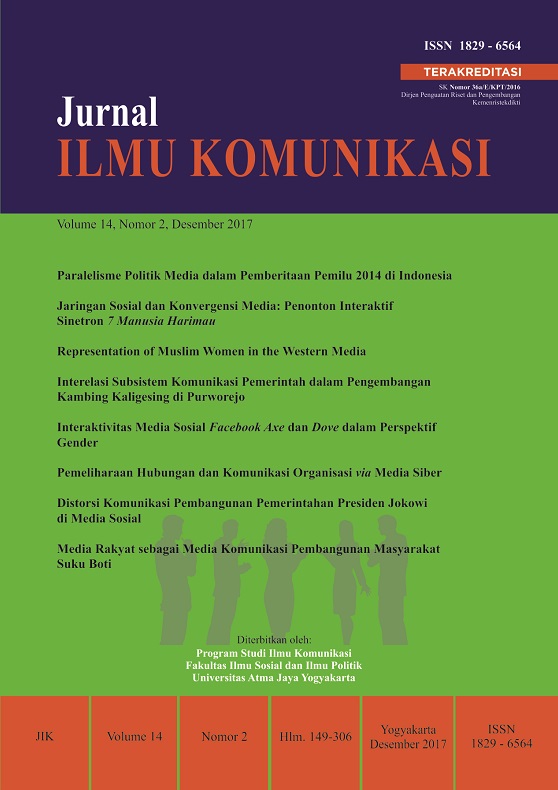Interaktivitas Media Sosial Facebook Axe dan Dove dalam Perspektif Gender
DOI:
https://doi.org/10.24002/jik.v14i2.966Keywords:
advertising, brand Axe, brand Dove, gender, interactivityAbstract
The objective of this research was to review an interactivity on Facebook accounts of brand Axe and Dove. The interactivity itself has been analyzed using content analysis method. The finding of the research were (1) Facebook account consists of advertising campaign; (2) The messages involve of verbal and non-verbal messages; (3) The audiences respond showed positive, negative, and neutral responses; (4) The number of audiences respond were dominated by male on Axe account and female for Dove account. The tendency of female responses were communicative and active. Meanwhile, the male responses were passive, weak, and communicative.
References
Bray, J. P. (2008). Consumer Behaviour Theory: Approaches and Models. Retrieved from: http://eprints.bournemouth.ac.uk/10107/
Chow, Andrew. (2013). Managing positive, neutral, and negative comments on social media. Techinasia.com (online). Diakses dari: https://www.techinasia.com/managing-positive-neutral-and-negative-comments-on-social-media pada 10 Januari 2017.
Chris, Alex. (2013). Difference between digital marketing and social media. Reliablesoft.net (online). Terarsip dalam: https://www.reliablesoft.net/difference-between-digital-marketing-and-social-media/, tanggal 31 Mei 2016.
Chwialkowska, Agniezka. (2016). Cultural perspective on the motivational drivers of engagement with brand content on social media: a set of research proposition. In Bernadas, Christine dan Michella, Delphine. Proceedings of the 3rd European Conference on Social Media. France: EM Normandie. Diakses dari: https://books.google.co.id/books?id=1DaeDAAAQBAJ&printsec=frontcover#v=onepage&q&f=false pada tanggal 10 Januari 2017.
Eriyanto. (2011). Analisis Isi, Pengantar Metodologi untuk Penelitian Ilmu Komunikasi dan Ilmu-ilmu Sosial Lainnya. Jakarta: Prena Media Group.
Fanpagekarma. (2016). Benchmarking Report Facebook. Terarsip dalam: http://www.fanpagekarma.com/facebook, diakses pada tanggal 13 Juli 2016.
Ganguly, Sonny. (2015). Why Social Media Advertising Is Set To Explode In The Next 3 Years. Marketingland (online). Terarsip dalam: http://marketingland.com/social-media-advertising-set-explode-next-3-years-121691, diakses tanggal 31 Mei 2016.
Gauntlett, D. (2002). Media, Gender and Identity: An Introduction. London: Routledge
Gensler, S., Völckner, F., Liu-Thompkins, Y., & Wiertz, C. (2013). Managing Brands in the Social Media Environment. Journal of Interactive Marketing, 27, 242–256.
Gurau, C. (2008). Integrated online marketing communication: implementation and management. Journal of Communication Management, 12(2), 169-184.
Heding, T., Knudtzen, C.F. dan Bjerre, M. (2009). Brand Management: Research, Theory and Practice. New York: Routledge.
Krippendorff, Klaus. (2004). Content Analysis: An Introduction to Its Methodology. Second Edition. California: Sage Publications. Inc. Terarsip dalam: http://en.bookfi.org/book/1148230, diakses pada tanggal 3 Desember 2016.
Kurnia, N. (2004). Representasi Maskulinitas dalam Iklan. Jurnal Ilmu Sosial dan Ilmu Politik, 8(1), 17-36.
Ksiazek, T.B., Peer, L. & Lessard, K. (2016). User engagement with online news: Conceptualizing interactivity and exploring the relationship between online news videos and user comments. Journal New Media & Society, 18(3), 502–520.
O’Barr, W. (2006). Representations of Masculinity and Femininity in Advertising, Advertising & Society Review, 7(2), DOI: 10.1353/asr.2006.0028.
O’Keefe, Daniel J. (1990). Persuasion. Theory and Research. New Delhi: Sage Publication.
Patterson, M., O’Malley, L. and Story, V. (2009). Women in Advertising: Representations, Repercussions, Responses. Irish Marketing Review, 20(1), 9-22.
Simmons, G.J. (2007). I-Branding: Developing the Internet as a Branding Tool. Marketing Intelligence & Planning, 25(6), 544-562.
Shin, Dong-Hee, Ounjung Roh. (2016). Social Television and Locus of Control: Interactivity Effects on Cognition and Behavior. Journal Social Behavior And Personality, 44(10), 1671–1686. http://dx.doi.org/10.2224/sbp.2016.44.10.1671
Stokes, Robb. (2014). eMarketing: The Essential Guide to Marketing in Digital World (5th Ed.). London: Quirk.
West and Turner. (2008). Introducing Communication Theory. USA: McGraw Hill.
Van Leeuwen, T. (2005). Introducing Social Semiotics, US: Routledge.
Zakia, R. and Nadin, M. 1987. Semiotics, Advertising, and Marketing. Journal of Consumer Marketing, 4(2), 5-12.
Downloads
Published
How to Cite
Issue
Section
License
Jurnal ILMU KOMUNIKASI is an academic journal. As such, it is dedicated to the open exchange of information. For this reason, JIK is freely available to individuals and institutions. Authors who publish in Jurnal ILMU KOMUNIKASI will release their articles under the Creative Commons Attribution (BY) License. This license allows anyone to copy and redistribute the article in any medium or format as well as remix, transform, and build upon the material for any purpose, even commercially as long as they credit the authors for the original creation. For details of the rights authors grants users of their work, see the "human-readable summary" of the license, with a link to the full license. (Note that "you" refers to a user, not an author, in the summary)
 This work is licensed under a Creative Commons Attribution 4.0 International License.
This work is licensed under a Creative Commons Attribution 4.0 International License.














